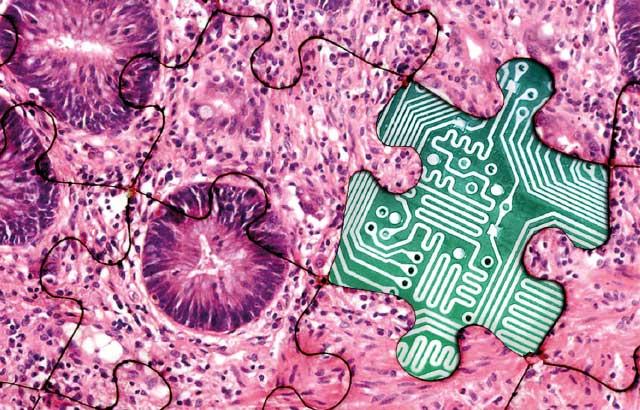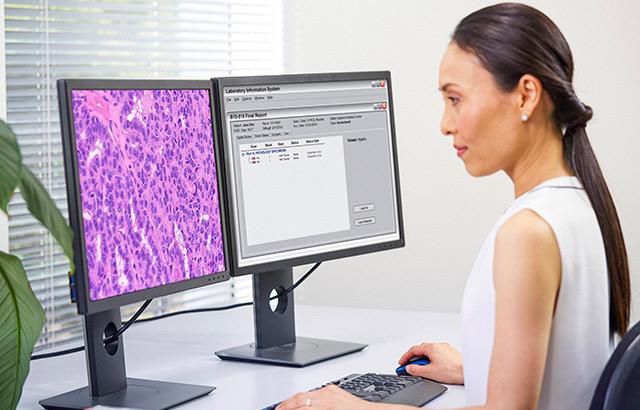
Creating Digital Ready Slides - A Practical Guide

The adoption of digital pathology is a multifaceted project involving many stakeholders across the pathology department. The impact on the laboratory is not isolated to simply installing a scanner but rather affects the whole workflow to generate optimized Digital Ready Slides. Standardization of histological slide preparation requires focusing on optimizing individual workflow steps and a holistic overview of the complete process from sample acquisition right through to diagnosis. Knowing this in advance and taking appropriate steps to support effectively change management can promote engagement and pave a path to success.
Key Learning Objectives:
- Define the critical attributes of Digital Ready Slides
- Demonstrate the impact of tissue preparation steps on scan quality
- Provide practical guidance to creating Digital Ready Slides and additional considerations at each laboratory step
발표자 소개

Dr. Colgan has over a decade of experience in the digital pathology sector and is focused on how this new and disruptive technology can be leveraged to provide real benefits in both the healthcare and research domains. Prior to working with Leica Biosystems, she came from a research background with a BSc in Biotechnology and a PhD in Vascular Biology from Dublin City University, Ireland.
참조 문헌
- Fraggetta, Filippo & Garozzo, Salvatore & Zannoni, GianFranco & Pantanowitz, Liron & Rossi, EstherDiana. (2017). Routine Digital Pathology Workflow: The Catania Experience. Journal of Pathology Informatics. 8. 51. 10.4103/jpi.jpi_58_17.
- Williams, Bethany & Hanby, Andrew & Millican‐Slater, Rebecca & Nijhawan, Anju & Verghese, Eldo & Treanor, Darren. (2017). Digital Pathology for the Primary Diagnosis of Breast Histopathological Specimens: An Innovative Validation and Concordance Study. Histopathology. 72. 10.1111/his.13403.
- Hanna, Matthew & Reuter, Victor & Ardon, Orly & Kim, David & Sirintrapun, Sahussapont & Schüffler, Peter & Busam, Klaus & Sauter, Jennifer & Brogi, Edi & Tan, Lee & Xu, Bin & Bale, Tejus & Agaram, Narasimhan & Tang, Laura & Ellenson, Lora & Philip, John & Corsale, Lorraine & Stamelos, Evangelos & Friedlander, Maria & Hameed, Meera. (2020). Validation of a digital pathology system including remote review during the COVID-19 pandemic. Modern Pathology. 33. 10.1038/s41379-020-0601-5.
- College of American Pathologists, “COVID-19 – Remote Sign-Out Guidance” (2020). Available at: capatholo.gy/3ghf4Wu.
- Centers for Medicare & Medicaid Services, “Clinical Laboratory Improvement Amendments (CLIA) Laboratory Guidance During COVID-19 Public Health Emergency” (2020). Available at: go.cms.gov/2LGD2wh.
- Royal College of Pathologists, “Guidance for remote reporting of digitalpathology slides during periods of exceptional service pressure” (2020). Available at: https://www.rcpath.org/profession/digital-pathology.html
- McCarthy, J. & Minsky, M.L. & Rochester, N. & Shannon, C.E.. (1955).proposal for the Dartmouth summer research project on artificial intelligence. Artificial Intelligence: Critical Concepts. 2. 44-53.
- Kanavati, Fahdi & Toyokawa, Gouji & Momosaki, Seiya & Rambeau, Michael & Kozuma, Yuka & Shoji, Fumihiro & Yamazaki, Koji & Takeo, Sadanori & Iizuka, Osamu & Tsuneki, Masayuki. (2020). Weakly-supervised learning for lung carcinoma classification using deep learning. Scientific Reports. 10.10.1038/s41598-020-66333-x.
- Iizuka, Osamu & Kanavati, Fahdi & Kato, Kei & Rambeau, Michael & Arihiro, Koji & Tsuneki, Masayuki. (2020). Deep Learning Models for Histopathological Classification of Gastric and Colonic Epithelial Tumours. Scientific Reports. 10. 10.1038/s41598-020-58467-9.
- McCampbell, Adrienne & Raghunathan, Varun & Tom-Moy, May & Workman, Richard & Haven, Rick & Ben-Dor, Amir & Rasmussen, Ole & Jacobsen, Lars & Lindberg, Martin & Yamada, N. & Schembri, Carol. (2017). Tissue Thickness Effects on Immunohistochemical Staining Intensity of Markers of Cancer. Applied Immunohistochemistry & Molecular Morphology. 27. 1. 10.1097/PAI.0000000000000593.
- Masuda, Shinobu & Suzuki, Ryohei & Kitano, Yuriko & Nishimaki, Haruna & Kobayashi, Hiroko & Nakanishi, Yoko & Yokoi, Hideo. (2020). Tissue Thickness Interferes With the Estimation of the Immunohistochemical Intensity: Introduction of a Control System for Managing Tissue Thickness. Applied Immunohistochemistry & Molecular Morphology. Publish Ahead of Print. 1. 10.1097/PAI.0000000000000859.
- Arif, Ahmed & Stuerzlinger, Wolfgang. (2009). Analysis of text entry performance metrics. TIC-STH’09: 2009 IEEE Toronto International Conference - Science and Technology for Humanity. 100 - 105. 10.1109/TICSTH.2009.5444533.
Related Content
라이카 바이오시스템즈 Knowledge Pathway 콘텐츠는 에서 이용할 수 있는 라이카 바이오시스템즈 웹사이트 이용 약관의 적용을 받습니다. 법적고지. 라이카 바이오시스템즈 웨비나, 교육 프레젠테이션 및 관련 자료는 특별 주제 관련 일반 정보를 제공하지만 의료, 규정 또는 법률 상담으로 제공되지 않으며 해석되어서는 안 됩니다. 관점과 의견은 발표자/저자의 개인 관점과 의견이며 라이카 바이오시스템즈, 그 직원 또는 대행사의 관점이나 의견을 나타내거나 반영하지 않습니다. 제3자 자원 또는 콘텐츠에 대한 액세스를 제공하는 콘텐츠에 포함된 모든 링크는 오직 편의를 위해 제공됩니다.
모든 제품 사용에 다양한 제품 및 장치의 제품 정보 가이드, 부속 문서 및 작동 설명서를 참조해야 합니다.
Copyright © 2024 Leica Biosystems division of Leica Microsystems, Inc. and its Leica Biosystems affiliates. All rights reserved. LEICA and the Leica Logo are registered trademarks of Leica Microsystems IR GmbH.



